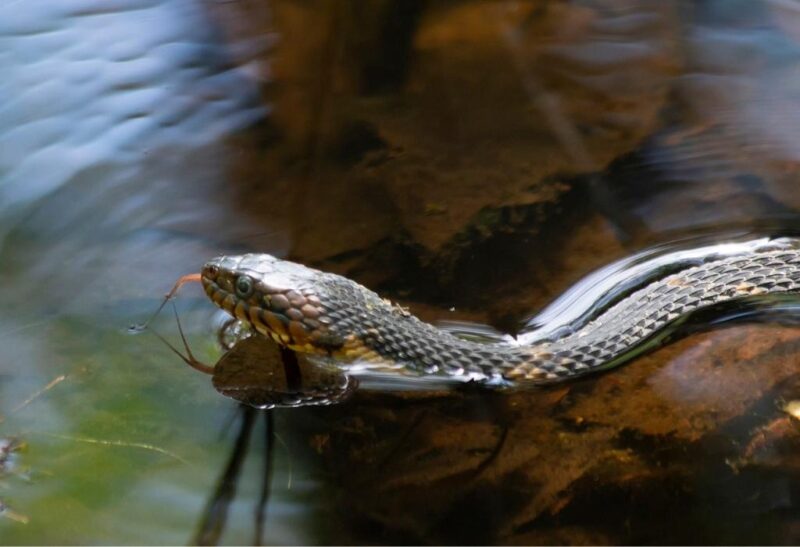All snakes can swim, but water snakes do it for the sake of hunting food. They prey on animals that live in the water, like crayfish, lizards, fish, amphibians, and insects.
Although they scare most people, these creatures have a vital role in Missouri’s ecosystem.
What are the types of water snakes in Missouri? The water snakes in Missouri are called Water Moccasin, Western Mud Snake, Mississippi Green Water Snake, Graham’s Crayfish Snake, Broad-banded Water Snake, Yellow-bellied Water Snake, Diamondback Water Snake, and Northern Water Snake.
Knowing their names is not enough, it’s best to identify each of them through their appearance, traits, behavior, and habits. It also includes the confirmation of whether they’re venomous or not. This article will tell you all of these things.
Table of Contents
Water Snake Characteristics
Water snakes have firm, keeled scales that cover their stout bodies and triangular heads where you can find their eyes with round pupils. Hence, they’re rough to touch.
Their color varies as it depends on the species. Nonetheless, they’re typically in the hues of brown, black, red, and olive green.
Some splotches and bands can also be seen on their backs. They grow around 3 to 5 feet, and females are longer and heavier than their male counterparts. Based on their length, they’re large, so people easily get scared of them.
8 Water Snakes in Missouri
Water Moccasin
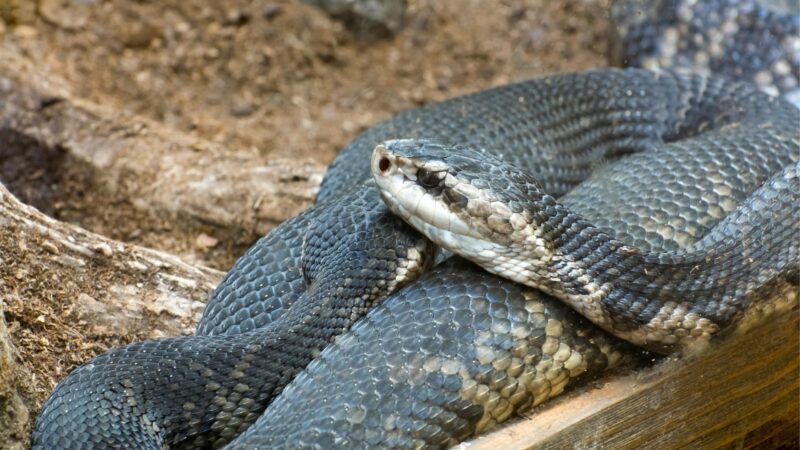
Water Moccasins, also known as cottonmouth, prefer wetlands and moist habitats. These snakes are solitary, so they rarely wander away from their home range. When a water moccasin swims, you’ll see its head and back on the water surface.
They become aggressive when disturbed or provoked. So, they can bite, but there will be warnings like coiling and elevating their heads a few inches away from the ground, shaking their tails, and giving off a rustling sound.
- Scientific Name: Agkistrodon piscivorus
- Appearance: These are large, heavy-bodied snakes with keeled scales. Their coloring varies, and when they’re still juvenile, they have bright colors. It darkens as they mature. Furthermore, they have a large, triangular head, large jowls, and elliptical eyes.
- Color: Brown to yellow with dark cross bands
- Lifespan: 18- 24 years
- Length: Up to 70 inches
- Diet: Amphibians, birds, carrion, eggs, fish, insects, mollusks, reptiles
- Place of Origin: Missouri and Virginia
- Venomous: Yes
Western Mud Snake
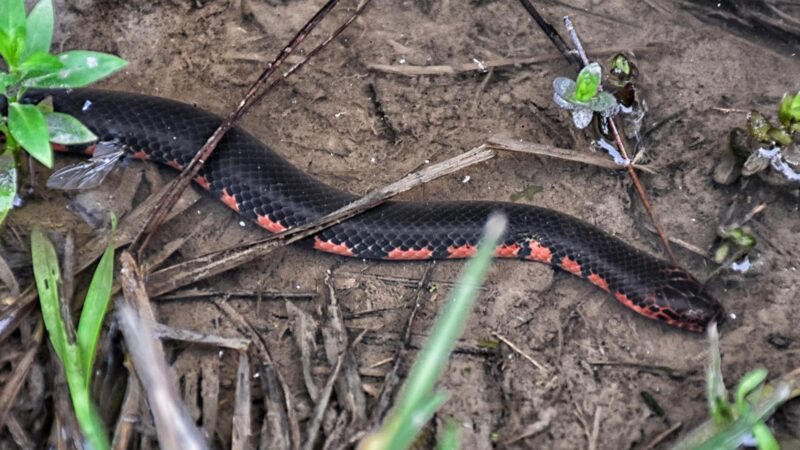
This snake chooses to be active at night, and it usually hides in burrows or under logs. It won’t bite for defense but prick you using its tail. This snake will also play dead when it senses a threat.
- Scientific Name: Farancia abacura reinwardtii
- Appearance: It has a slightly flattened head and tail with a sharp scale.
- Color: Black with a red underside
- Lifespan: 19 years
- Length: 40-54 inches but can grow up to 72 inches
- Diet: Aquatic amphiuma, eel, salamander, frogs, and siren
- Place of Origin: Gulf Coast region
- Venomous: No
Mississippi Green Water Snake
This water snake likes warm days, and it hunts in the evening and at night. You’ll likely see it hanging on the branch above the water.
It expels foul-smelling musk when it’s in a defensive stance, and it can bite as well.
- Scientific Name: Nerodia cyclopion
- Appearance: A Mississippi green water snake is a medium-sized snake with dark color. It has half-moon markings.
- Color: Brown, dark green, dark grey
- Lifespan: 3 months-3 years
- Length: 30-45 inches
- Diet: Fish, frogs, small crabs, and crayfish
- Place of Origin: Southeastern Missouri
- Venomous: No
Graham’s Crayfish Snake

You will likely see this snake on branches over the water as it tries to hunt for food. Also, it can be found in crayfish burrows and under rocks or logs.
It rarely bites, but it releases a bad scent if handled or caught. This snake is secretive, so it’s hard to catch.
- Scientific Name: Regina grahamii
- Appearance: It has a grey or brown back with yellow lower sides. The belly has a cream color.
- Color: Grey, yellow, cream, brown
- Lifespan: Unknown
- Length: 18-28 inches
- Diet: Crayfish, tadpoles, and frogs
- Place of Origin: Central United States
- Venomous: No
Broad-Banded Water Snake
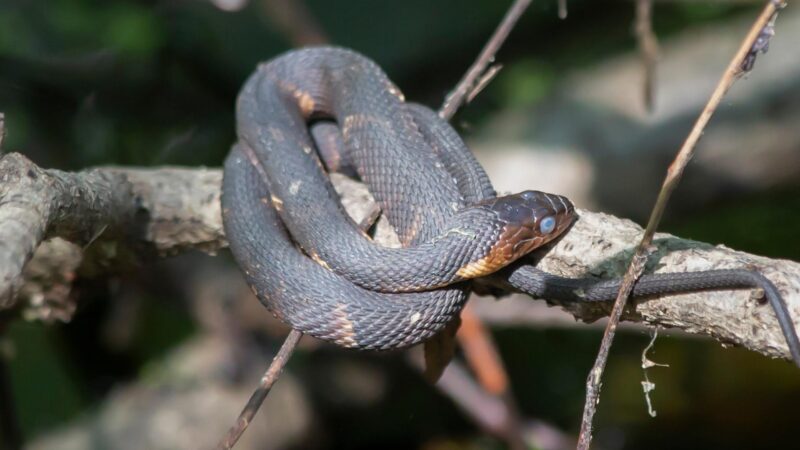
When the weather is hot, broad-banded water snakes prefer to be more active at night. But they like sunbathing on logs and trees. It flattens itself when threatened, but it can bite too. Its preferred habitat is a swamp, lake, or river.
- Scientific Name: Nerodia fasciata confluens
- Appearance: The distinct feature of this water snake is the stripe from its eye to its jaw’s angle.
- Color: Black, bright yellow
- Lifespan: 7-8 years
- Length: 22-36 inches
- Diet: Tadpoles, frogs, toads, and fish
- Place of Origin: Southeastern part of the United States
- Venomous: No
Yellow-Bellied Water Snake
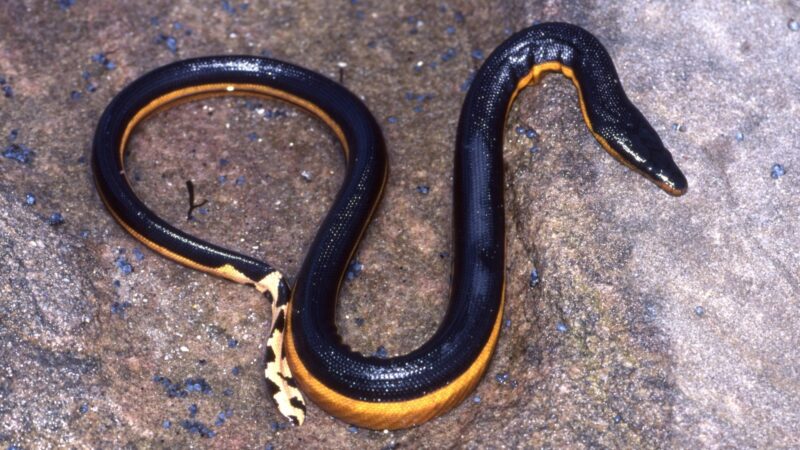
This snake resides in calm waters. It also spends time basking on branches and logs that are near those waters.
- Scientific Name: Nerodia erythrogaster flavigatser
- Appearance: It has a dark body with a yellow belly, and that’s how it got its name. There’s no pattern on its body.
- Color: Black, brown, gray, pink, and olive-gray
- Lifespan: 8-15 years
- Length: 30-48 inches
- Diet: Frogs, toads, tadpoles, crayfish, fish, and salamander
- Place of Origin: All over the United States
- Venomous: No
Diamondback Water Snake
Just like other water snakes, it hangs on a branch and dips its head into the nearby water to find food.
It uses its sharp teeth to grab its prey. Due to its teeth, its bite can be painful after it hisses and flattens its body when feeling threatened.
- Scientific Name: Nerodia rhombifer rhombifer
- Appearance: Its back is either grey or light brown with dark diamonds and a light color outline. It has a yellow belly with crescent marks and dark splotches.
- Color: Grey, light brown, and yellow
- Lifespan: 5-10 years
- Length: 30-48 inches
- Diet: Salamanders, toads, and fish that moves slowly or dead ones
- Place of Origin: Northern, Western, and Southeast parts of the United States
- Venomous: No
Northern Water Snake
It becomes nocturnal when the weather becomes hot. You’ll likely find it on rocks, logs, and hanging on a branch as it reaches the water for food.
- Scientific Name: Nerodia sipedon sipedon
- Appearance: There are square blotches on its sides, while its belly can be colored yellow, white, or orange. There are black edges that are like a half-moon. It has a divided anal plate.
- Color: Grey, brown, cream, orange, and red
- Lifespan: Up to 9 years
- Length: 24-42 inches
- Diet: Small fish and amphibians
- Place of Origin: Northeast to Southern parts of the United States
- Venomous: No
Frequently Asked Questions
Can a Water Snake Hurt You?
It depends on the situation, but as long as you don’t get close to it, you won’t get hurt. A water snake can bite if it feels threatened.
Although they’re generally non-venomous to humans, they have a set of teeth that can leave more than just a scratch on your skin. It can cause bleeding, but it will only happen if you harass a water snake.
How Poisonous is a Water Snake?
It’s not poisonous, but it’s usually a large snake, so its bite can be painful.
Are Sea Snakes Aggressive?
They’re not aggressive, but they bite when surprised or threatened. Fishermen are the ones likely to get bitten as there are chances that they need to remove the snake from their netting.
The bite of sea snakes is envenomation which means you won’t realize right away that you got bitten. It’s due to their small teeth.
What Happens if You Get Bit by a Sea Snake?
Be aware that the bite of sea snakes contains a potent neurotoxin. It can cause morbidity and even fatality if not given the necessary treatment.
These consequences can be brought by the toxins that can paralyze the diaphragm, respiratory muscles, and skeletal muscles.
What Do You Do if You See a Sea Snake?
Once you discover the symptoms of the envenomation from a sea snake, you have to take antivenin with no delay.
The patient shouldn’t stay in the water as he or she might get drowned when the body becomes paralyzed.
Mechanical and intubation ventilation may be necessary before administration of antivenin because the respiratory system of the patient can be compromised.
A small amount of venom from the bite can be extracted through incision, suctioning, and drainage.
This is done to ensure that the person is safe from infection and skin damage. The wound should be wrapped with a bandage that immobilizes pressure so the venom won’t spread to other parts of the body.
When there’s no antivenin in refractory cases, hemodialysis is an option. The patient may also need an electrolyte supplement.
Summary
Water snakes are generally harmless when you don’t get near or try to provoke them. You’ll likely get scared seeing them as they’re large. But they’re not after humans as they eat what they can find in the water.
Sea snakes are dangerous ones as they have toxins and venom that can cause illness and even death when not treated in due time.
List of Sources
Semi-Aquatic Snakes of Missouri
